A fox went out on a chilly night, and five kits followed her, tumbling out from their burrow and scampering up a wooded hill. She stood on full alert as she nursed them, and shook them off before they were ready to release her. Over the next hour or so, as the youngsters played, she and her mate brought back two fresh food offerings: some small creature that was immediately ripped into shreds by a parent and swarmed by the kits, and a vole that was heavily mouthed by a parent then obscured beneath leaves. There was also evidence of a previous meal, as several kits paraded around bearing large white tufts of fur.
It’s fairly common to see fox kits this time of year, although I’ve never had the privilege to see so much family interaction. This chance came through a friend who has hosted generations of foxes under a shed in a town setting; for good or ill, the parents have acclimated to living in close quarters to human activity. As for the kits, they’re at that weaning stage where they’re up from the den but still have their dark baby fuzz and haven’t yet learned to be shy. The kits came within a few feet of us, and I’ve seen similar behavior in much more remote settings; I can see why people occasionally mistake them for lost puppies.
We have a number of foxy features in our on-line archive; here’s an article by Meghan McCarthy McPhaul describing vulpine family life, and an excerpt from a tracking book by author David Brown. If you do see fox kits, red or gray, count yourself lucky. It’s a fleeting moment; they’ll soon realize they’re wild animals and vanish into the woods.
Fox family life and fox life cycle
Foxes(both Red and Gray) mate from December to February and announce the process with loud, far-carrying vocalisations typified by a barking ‘wow-wow-wow’ and an eerie, high-pitched ‘waaaaaaaa’.
Underground breeding dens in banks on open ground or at woodland edges may be excavated in preparation for the birth of the cubs, although New Forest foxes often seem to take the easy option and commandeer and enlarge part of a heathland rabbit warren or, perhaps surprisingly, cohabit with badgers in a woodland sett – the badgers live at one end of the sett, the foxes at the other, with rabbits sometimes in-between, almost acting as a ready-made larder.
The foxes and badgers will usually maintain a polite distance, but in the event of aggression, it’s likely that the badger will triumph. Both fox and badger, though, show the utmost respect for one another.
Fox gestation period is around 52 days, births are usually in March or April, and the typical litter size is 4 or 5 cubs, although in the New Forest, litters of 6, or sometimes more, are not uncommon.
Fox cubs at birth are blind and deaf, their nose is relatively short, their ears are small and floppy, and their fur is short and very dark. The vixen’s body heat is needed by the cubs for the first 2 to 3 weeks of life - during at least the early part of this period, she is provisioned by the male: he leaves food by the den entrance for her.
After around 4 weeks, the cubs first venture above ground, hesitantly initially. By this time, their coat is darkish brown with a reddy tinge to the face, their ears are more like those of adults: longer and erect; and their muzzle has lengthened and will continue to do so as adult facial features are progressively developed over the next 4 - 6 weeks. Adult coat colour is also fully assumed over this period, starting, at least in some animals, at the front and working backwards.
Following first emergence, hunting and foraging instincts quickly kick in as the cubs seek out earthworms and insects to supplement a mixture of 'mother's milk' and solid food brought back for them by both the dog fox and vixen. Relatively large mammals, such as rabbits, and birds are often provided for the cubs, whilst for themselves, the adults apparently favour smaller prey items, such as mice and voles.
Returning fox parents are usually greeted with a great deal of excitement by the hungry cubs. In fact, it is probably more accurate to say that a chaotic melee ensues.
When not fully weaned, some of the fox cubs may immediately suckle the returning vixen, whilst whatever prey item has been brought back will be quickly taken and carried away by other, maybe more developed, youngsters, often after a spirited tug-of-war between competing siblings. Those that miss out on the solid food and are unable, or not inclined, to suckle may simply, agitatedly nuzzle the adult's mouth and throat, and maybe whine, to encourage regurgitation of partly digested food and maybe spur on a speedy resumption of hunting.
Cubs are suckled for around 4 weeks and progressively weaned thereafter. Some are fully weaned by around 6 - 7 weeks of age, whilst others may still be suckling well beyond this stage.
Certainly not all cubs necessarily develop at the same rate, for within a litter may be very well-grown, well-fed, dominant youngsters - almost miniature adults in appearance - that, by virtue of their strength, regularly succeed when competing for food with siblings; alongside other smaller, less developed, subordinate cubs that still retain their 'baby face' features. Indeed, right from birth, cubs - like many other wild creatures - are in a battle for life where only the fittest survive.
Almost inevitably, some cubs do not survive, and it has been said that in the first weeks of life, as many as 20% die underground, often as a result of squabbles with siblings, their tiny, lifeless bodies consumed by surviving brothers and sisters. Maybe the unfortunates were inherently weak - the runts of the litter - and destined for a short life; or maybe they were simply unlucky, always at the end of the queue when trying to suckle.
For cubs that do survive the sometimes traumatic early stages of life, growth in times of plenty is often rapid, and by summer they are of similar appearance to the adults, although often with a tendency towards a more long-legged, lanky look. By early autumn, when around 6 - 7 months old, after their winter coat has replaced that of summer, they are largely indistinguishable from adults.
In the weeks immediately after first emergence, cubs tend to stay close to the den, but as confidence grows they progressively wander farther afield, spurred on in part by curiosity, in part by growing mobility and in part by the natural urge for independence.
Research from elsewhere suggests that cubs abandon the den in June and lie up during the day in undergrowth - in the New Forest, mature bracken often obscures the view, but there is no reason to believe that behaviour here is any different to that of other country foxes. In July, apparently, they increasingly follow their parents on hunting expeditions and start to forage for themselves, and some or all of those that manage to survive - a relatively small proportion of the cubs born in spring - fully disperse from late-September through to late-winter.
A fox and cub on the move
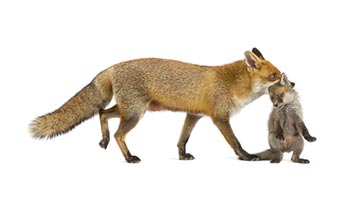
If subject to unacceptable levels of disturbance, including by badgers, foxes will move their cubs, particularly very young ones, to another nearby den. I’ve also at dusk watched a fox emerge from one part of a badgers’ sett, scent-mark around the entrances, and then go off to hunt. Minutes later, a badger emerged from a nearby sett entrance, diligently sniffed the air, and then rapidly moved its cubs, one at a time, picked up by the scruff of the neck, to another part of the sett. (Illustration courtesy of Dreamstime.com, other images copyright Andrew P. Walmsley).
Dominant cubs survive;
the weak may perish
the weak may perish
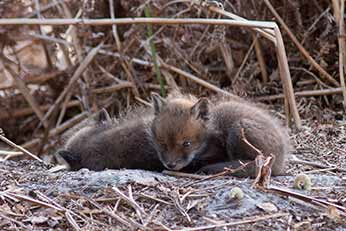
Some years ago, I watched cubs at a den near Fritham and noticed on a number of occasions within a few days, a very small, weak-looking cub curled up in bracken beside a holly bush at least 50 metres from the main den area. It didn't attempt to move away, but simply stared back at me as I passed within a few feet, en-route to my watching position.Eventually I saw it no more and assume that it perished. Maybe for whatever reason it had been ostracised by the group, or had simply tired of being persecuted by more dominant cubs, or ignored by adults that favoured the stronger animals. Whichever applied, it certainly seems unlikely that it would have had access to food so far away from the main den.
Similarly, at a den not far from Lyndhurst, two of a litter of six - tiny creatures still with much dark brown fur and 'baby' faces - spent a lot of time inactive above ground, even during the day, curled up on a den entrance spoil heap and tolerant of my nearby presence, seemingly without the energy, or not inclined, to move underground - they're shown above.
Three others in the litter were hardly more developed, whilst one was particularly well-grown, with sandy-red fur and almost fully formed foxy facial features, a dominant animal that I watched regularly target more weakly siblings during bouts of 'play' fighting.
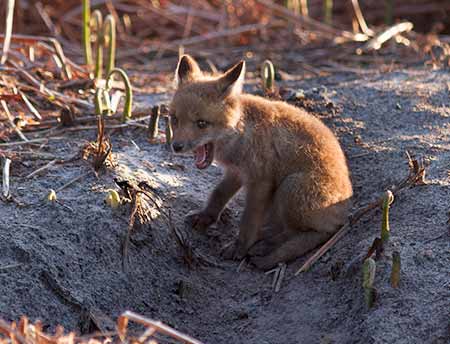 After a 7 day break from watching, I returned to the den to find only the dominant cub present, frequently whining in the direction of the main den entrance, apparently trying to coax the others out - it's shown above. No other cubs appeared, I know not why - maybe they had been moved to another den, maybe they had perished for want of food or on a busy nearby road, or maybe there were other more sinister, human-related reasons for their apparent disappearance.
After a 7 day break from watching, I returned to the den to find only the dominant cub present, frequently whining in the direction of the main den entrance, apparently trying to coax the others out - it's shown above. No other cubs appeared, I know not why - maybe they had been moved to another den, maybe they had perished for want of food or on a busy nearby road, or maybe there were other more sinister, human-related reasons for their apparent disappearance.
Similarly, at a den not far from Lyndhurst, two of a litter of six - tiny creatures still with much dark brown fur and 'baby' faces - spent a lot of time inactive above ground, even during the day, curled up on a den entrance spoil heap and tolerant of my nearby presence, seemingly without the energy, or not inclined, to move underground - they're shown above.
Three others in the litter were hardly more developed, whilst one was particularly well-grown, with sandy-red fur and almost fully formed foxy facial features, a dominant animal that I watched regularly target more weakly siblings during bouts of 'play' fighting.
 After a 7 day break from watching, I returned to the den to find only the dominant cub present, frequently whining in the direction of the main den entrance, apparently trying to coax the others out - it's shown above. No other cubs appeared, I know not why - maybe they had been moved to another den, maybe they had perished for want of food or on a busy nearby road, or maybe there were other more sinister, human-related reasons for their apparent disappearance.
After a 7 day break from watching, I returned to the den to find only the dominant cub present, frequently whining in the direction of the main den entrance, apparently trying to coax the others out - it's shown above. No other cubs appeared, I know not why - maybe they had been moved to another den, maybe they had perished for want of food or on a busy nearby road, or maybe there were other more sinister, human-related reasons for their apparent disappearance.
'Play' fights help to establish
and maintain the cubs'
status within the group
and maintain the cubs'
status within the group
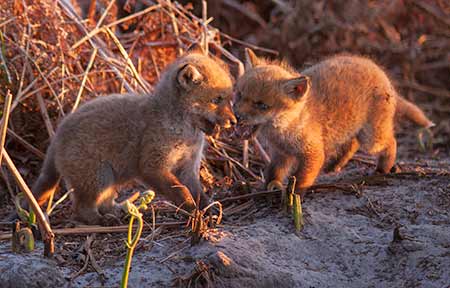
Frequent 'play' fights take place amongst very young cubs, to help establish and maintain status within the group and as an aid to honing hunting skills in preparation for the rigours of the world away from the den. Some fights seem to simply be fun activities, but the one shown here was none-too-friendly - it's perhaps not surprising that weaker animals try to stay well away from stronger rivals. Hierarchies amongst the cubs are apparently well-established by the time they are 7 or 8 weeks old, and serious fights after that time are unusual.
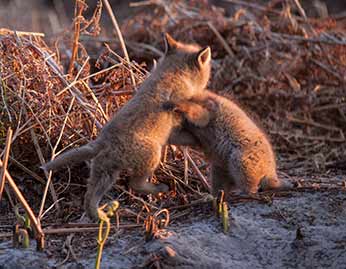
The waiting game
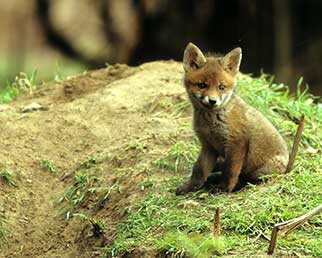
wandering about, sometimes
in search of tasty earthworm
and insect morsels amongst
the grass or leaf litter.
At last, food
is delivered
is delivered
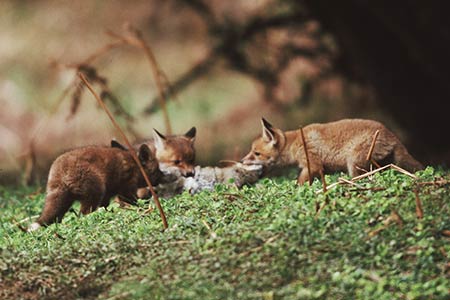
being pulled apart. A tug-of-war
(seen underway here) helps
break open the prey whilst also
ensuring that the larger, more
dominant cubs enjoy the lion's
share of the spoils.
Disturbance at the den -
friend or foe?
friend or foe?
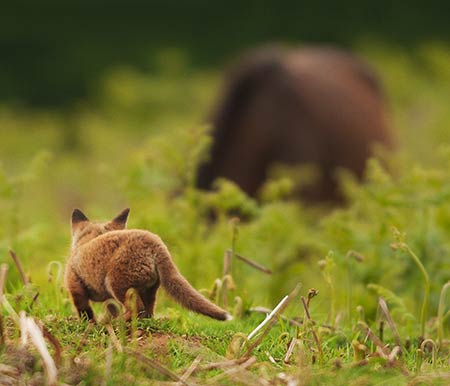
wants to investigate, but
shows no sign of fear.
Growth is rapid
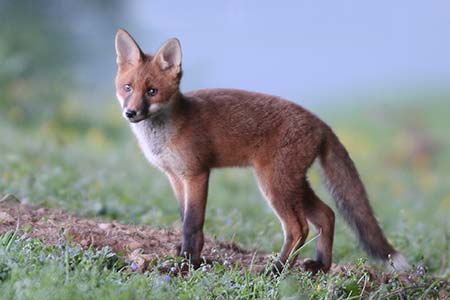
time would not normally be
so well-grown. It is more
likely that it is actually a
very thin, gangly young adult,
a first time breeder that has
been too busy feeding its
cubs rather than i
















No comments:
Post a Comment